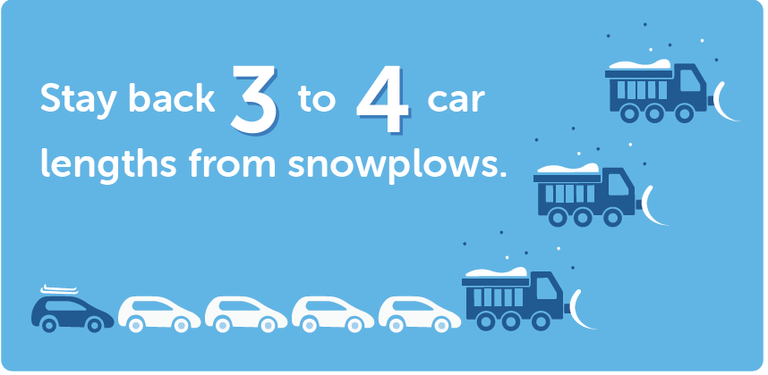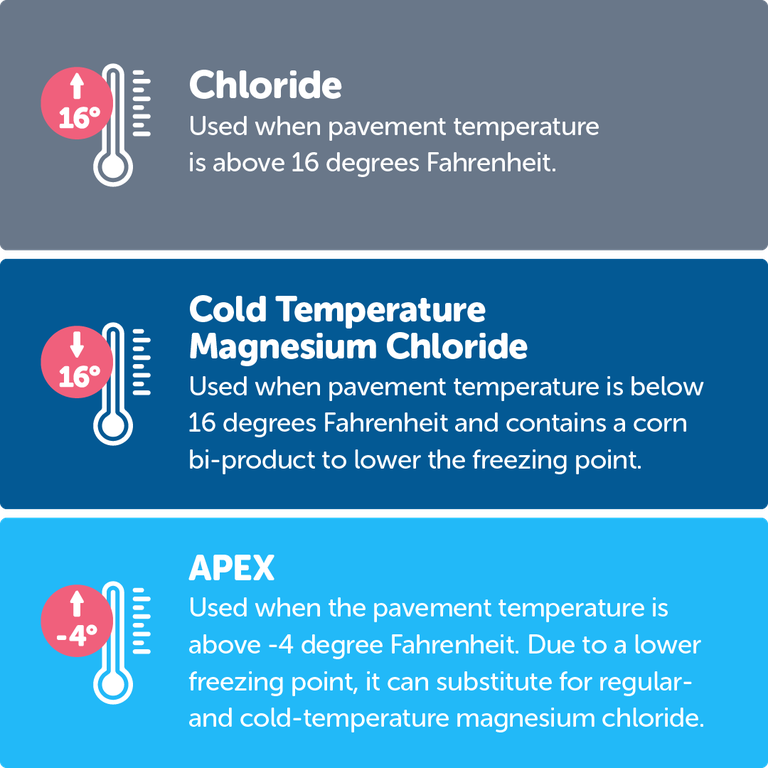Snow Removal & Safety
Snow the Facts
Whether it’s before, during, or after winter weather, CDOT uses various snow removal equipment, techniques and products to keep roads clear and travelers safe. Read the information below to learn more about the Tandem Snowplow Law and how CDOT removes snow from winter roads.
 Snowplow Safety
Snowplow Safety
Tandem Snowplow Law
In 2019, Gov. Jared Polis signed House Bill 19-1265 into law, increasing penalties for motorists who pass snowplows.
It is now a Class A traffic offense to pass a snowplow operated by a state, county or local agency when the truck is displaying its lights and operating in a tandem formation with one or more snowplows.
What is “Tandem Formation”?
When snowplows operate in tandem formation, multiple plows are staggered diagonally to cover all lanes and clear the entire roadway in one sweep. Each snowplow is stationed behind and to the right or left of the unit ahead. This is the safest and most efficient snow removal method.
It is extremely dangerous for motorists to try and pass plows in this formation because you could encounter white-out conditions and ridges of snow between lanes.

Fines and Penalties
A Class A traffic offense includes fines ranging from $15 to $100, plus a surcharge. The Colorado DMV may also add points to the offender’s driver’s license.
Bow to the Plow!
In addition to never passing a snowplow in a tandem formation, there are two other dangerous maneuvers that all motorists must avoid for their own safety and others’:
- Tailgating — Plows need to drop de-icer and sand, so make sure you stay back 3-4 car lengths of space. If you follow too close, de-icer and sand could hit your car. You also never know when a plow might need to stop suddenly, so make sure you have plenty of room to do the same
- Passing on the Right — Never a good idea! Plows are designed to push all the snow, slush, rocks and other debris to the right. All that debris could damage your car and obstruct visibility.
Snowplow Tracker
Curious where CDOT’s snowplows are in your area? Please Note: Our current fleet of snowplows is getting an upgrade to the tracking software, and Plow Tracker is currently not available on COtrip.org. Our Maintenance & Operations team is working diligently to get all of our fleet updated with the new software, and Plow Tracker will be available in January/February 2022. Thank you for your patience.
CDOT uses a variety of snow removal strategies and products to treat Colorado highways during a winter storm.
When weather forecasts indicate the dispatch of snowplows will be necessary, CDOT mobilizes plows at the start of the storm and may put down a layer of liquid de-icer once snow starts to fall to help prevent the precipitation from freezing to the roadway surface.
After the layer of liquid de-icer is applied, snowplows operate around the clock on the state’s most heavily traveled roadways applying both liquid and solid de-icing products until their services are no longer needed. On roadways with fewer vehicles, snow removal hours may be limited.
Snow Removal Coverage
- On highways with annual average daily traffic of 1,000 vehicles or more, snow removal operations will occur throughout the storm (24 hours) until roads and highways are safe to drive.
- On highways with annual average daily traffic of fewer than 1,000 vehicles, snow removal operations are limited to 14 hours, from 5 a.m. to 7 p.m.
- Exceptions may be granted for school bus routes, highway segments with high accident rates, or hospital/emergency routes. While roads with fewer vehicles may have limited hours of snow removal during a typical snowstorm, CDOT will plow the roadway if the storm may cause road closures and safety risks. CDOT will also work with emergency service providers when emergency response is necessary.
CDOT uses a variety of products to treat Colorado highways during a winter storm. All snow removal products contain salt with added corrosion inhibitors used to prevent or remove the buildup of ice and snow on roads and minimize the impact on vehicles.
Anti-icing vs. De-icing
Anti-icing prevents snow and ice from bonding to the roadway, making it much easier for plows to clear the roads when combined with de-icers. CDOT's anti-icing product is applied hours before a storm and is a part of a pretreatment strategy designed to be more proactive while fighting adverse road conditions.
De-icing breaks the bond of already existing snow and ice. The de-icing products dissolve downward and penetrate until they reach the pavement. De-icers melt the ice and snow so it may be easily removed by mechanical means such as plows. They are not necessarily intended to clear every bit of ice and snow on the road, though the goal is to keep roads wet.
Both anti-icers and de-icers are winter road treatments that work as freezing-point depressants and are the most desirable and environmentally friendly way to treat winter weather roads.
Anti-icing Brine Mixers
CDOT makes an anti-icing brine mix in-house at a rate of 42 cents per gallon. This product is applied hours before a snowstorm or ice storm and will appear as white stripes on the roadway once dry.
Unlike other anti-icing products used throughout the country, CDOT's brine mix contains a corrosion inhibitor, which helps prevent damage on both vehicles and infrastructure. Once snow begins to fall, or the temperature drops below freezing, crews will stop using the anti-icer and switch over to de-icers.
Solid De-icers
Solid de-icers are used for ant-icing and de-icing on roadways during winter weather conditions. CDOT uses two types of solid de-icers:
- Ice slicer — made of granular salt and magnesium chloride.
- Sand or sand/salt mixture — mainly used in high elevations and the eastern plains where more extreme cold temperatures exist, and more traction is needed.
Liquid De-icers

- Chloride: Used when pavement temperature is above 16 degrees Fahrenheit
- Cold Temperature Magnesium Chloride: Used when pavement temperature is below 16 degrees Fahrenheit and contains a corn bi-product to lower the freezing point
- APEX: Used when the pavement temperature is above -4 degree Fahrenheit
- Due to a lower freezing point, it can be substituted for regular- and cold-temperature magnesium chloride.
Snow Removal Product Use
- Liquid and solid de-icers are used on interstates, freeways and divided highways as needed
- During a storm, liquid and solid de-icers are used only on highways with annual average daily traffic of more than 15,000 vehicles
- Following a storm, liquid and solid de-icers may be used on any highway if necessary
- Sand may be used on all state highways
CDOT is responsible for plowing state highways and interstates, which adds up to about 23,000 lane miles across Colorado. Individual municipalities are responsible for plowing their own local roads.
On highways with annual average daily traffic of 1,000 vehicles or more, snow removal operations will occur throughout the storm (24 hours) until normal driving conditions exist. On highways with daily traffic less than 1,000 vehicles, snow removal will occur from 5 a.m. to 7 p.m., with exceptions for school bus routes, highway segments with high accident rates, or hospital/emergency routes.
CDOT is looking to hire qualified snowplow drivers. If you have your commercial driver's license (CDL), apply here.
Visit the Winter Driving Preparedness page for tips for driving during winter weather.
After the layer of liquid de-icer is applied, snowplows are operated around-the-clock on the state’s most heavily traveled roadways applying both liquid and solid de-icing products until their services are no longer needed. On roadways with fewer vehicles, snow removal hours may be limited.
When weather forecasts indicate the dispatch of snowplows will be necessary, CDOT mobilizes plows at the start of the storm and may put down a layer of liquid de-icer once snow starts to fall to help prevent the precipitation from freezing to the roadway surface.
